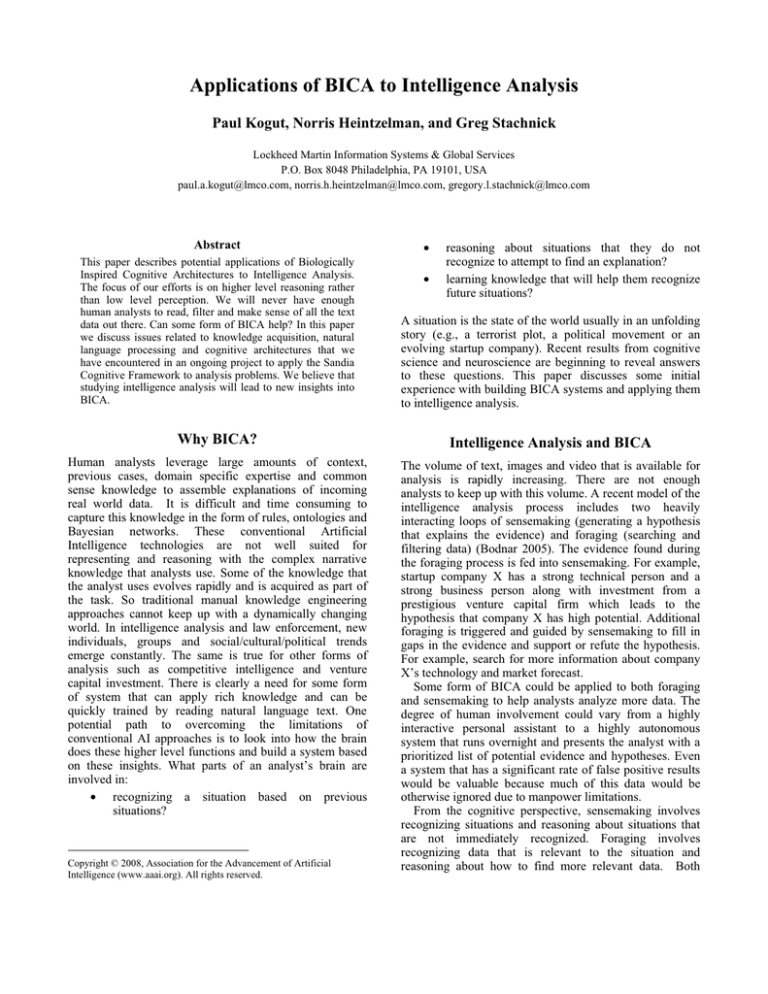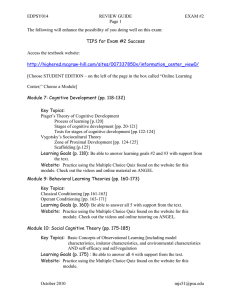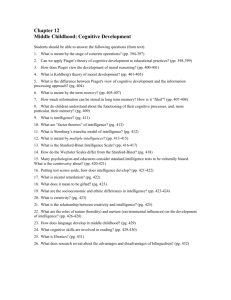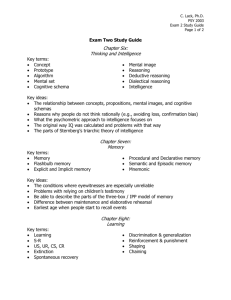
Applications of BICA to Intelligence Analysis
Paul Kogut, Norris Heintzelman, and Greg Stachnick
Lockheed Martin Information Systems & Global Services
P.O. Box 8048 Philadelphia, PA 19101, USA
paul.a.kogut@lmco.com, norris.h.heintzelman@lmco.com, gregory.l.stachnick@lmco.com
Abstract
•
reasoning about situations that they do not
recognize to attempt to find an explanation?
learning knowledge that will help them recognize
future situations?
This paper describes potential applications of Biologically
Inspired Cognitive Architectures to Intelligence Analysis.
The focus of our efforts is on higher level reasoning rather
than low level perception. We will never have enough
human analysts to read, filter and make sense of all the text
data out there. Can some form of BICA help? In this paper
we discuss issues related to knowledge acquisition, natural
language processing and cognitive architectures that we
have encountered in an ongoing project to apply the Sandia
Cognitive Framework to analysis problems. We believe that
studying intelligence analysis will lead to new insights into
BICA.
A situation is the state of the world usually in an unfolding
story (e.g., a terrorist plot, a political movement or an
evolving startup company). Recent results from cognitive
science and neuroscience are beginning to reveal answers
to these questions. This paper discusses some initial
experience with building BICA systems and applying them
to intelligence analysis.
Why BICA?
Intelligence Analysis and BICA
Human analysts leverage large amounts of context,
previous cases, domain specific expertise and common
sense knowledge to assemble explanations of incoming
real world data. It is difficult and time consuming to
capture this knowledge in the form of rules, ontologies and
Bayesian networks. These conventional Artificial
Intelligence technologies are not well suited for
representing and reasoning with the complex narrative
knowledge that analysts use. Some of the knowledge that
the analyst uses evolves rapidly and is acquired as part of
the task. So traditional manual knowledge engineering
approaches cannot keep up with a dynamically changing
world. In intelligence analysis and law enforcement, new
individuals, groups and social/cultural/political trends
emerge constantly. The same is true for other forms of
analysis such as competitive intelligence and venture
capital investment. There is clearly a need for some form
of system that can apply rich knowledge and can be
quickly trained by reading natural language text. One
potential path to overcoming the limitations of
conventional AI approaches is to look into how the brain
does these higher level functions and build a system based
on these insights. What parts of an analyst’s brain are
involved in:
• recognizing a situation based on previous
situations?
The volume of text, images and video that is available for
analysis is rapidly increasing. There are not enough
analysts to keep up with this volume. A recent model of the
intelligence analysis process includes two heavily
interacting loops of sensemaking (generating a hypothesis
that explains the evidence) and foraging (searching and
filtering data) (Bodnar 2005). The evidence found during
the foraging process is fed into sensemaking. For example,
startup company X has a strong technical person and a
strong business person along with investment from a
prestigious venture capital firm which leads to the
hypothesis that company X has high potential. Additional
foraging is triggered and guided by sensemaking to fill in
gaps in the evidence and support or refute the hypothesis.
For example, search for more information about company
X’s technology and market forecast.
Some form of BICA could be applied to both foraging
and sensemaking to help analysts analyze more data. The
degree of human involvement could vary from a highly
interactive personal assistant to a highly autonomous
system that runs overnight and presents the analyst with a
prioritized list of potential evidence and hypotheses. Even
a system that has a significant rate of false positive results
would be valuable because much of this data would be
otherwise ignored due to manpower limitations.
From the cognitive perspective, sensemaking involves
recognizing situations and reasoning about situations that
are not immediately recognized. Foraging involves
recognizing data that is relevant to the situation and
reasoning about how to find more relevant data. Both
Copyright © 2008, Association for the Advancement of Artificial
Intelligence (www.aaai.org). All rights reserved.
•
sensemaking and foraging require large amounts of
knowledge which implies the need for the general
cognitive processes of learning a large repertoire of
situations. So we believe that sensemaking, foraging and
the forms of learning associated with these processes
involve similar areas and pathways in the brain. The focus
of this investigation is on the cognitive processes that
happen in the hippocampus and cortex after low level
perception occurs. Sandia National Labs has been focusing
on these areas of the brain in the development of their
cognitive framework.
Intelligence Analysis BICA prototype
The goal of our initial prototype effort was to determine
the feasibility of applying BICA to analysis. The focus of
our initial prototype was sensemaking on evidence drawn
from text sources. The primary component for situation
recognition was the Sandia Cognitive Runtime Engine with
Active Memory (SCREAM) (Bernard 2006). SCREAM
has a semantic memory that supports associative priming
between concepts (e.g., doctor activates nurse). SCREAM
also has a hierarchical context module that supports bottom
up activation of contexts (e.g., doctor and nurse and bed
activate hospital) and top down priming of other expected
concepts (e.g., hospital activates emergency room).
In the initial prototype, the cognitive models used by
SCREAM were developed by traditional manual
knowledge engineering techniques. Perceptions in the form
of incrementally arriving text reports were processed with
hybrid natural language processing (NLP) techniques into
a form that would trigger activation of SCREAM concepts
and contexts. The NLP subsystem includes AeroText a
rule-based information extraction system and STANLEY a
statistical clustering tool (Bauer 2005). AeroText
recognizes multi-word named entities which STANLEY
uses as a basis for determining concept associations which
are then passed to SCREAM as perceptual inputs.
The output of SCREAM was an indication that one or
more higher level contexts (hypotheses) were activated.
The analyst could examine the hypothesis along with the
chain of activations that provides justification. SCREAM
tolerates inconsistencies unlike logic based rules and
ontologies. The highest level of hypothesis in the
experiment was supported by 30 pieces of evidence with
multiple inference chains that had up to 6 steps.
We also experimented with a novel approach for
reasoning about situations that are not immediately
recognized by SCREAM (e.g., a previously unseen
situation). We investigated the use of an abductive
reasoning system called the Peircean Decision Aid (PDA)
(Senglaub 2008) to activate additional contexts based on
past experience derived by induction from data in previous
situations rather than actual evidence in the current
situation. For example, it is plausible that an object can be
used for a certain purpose but there is no evidence yet that
there is intention to use it that way.
Future Research
There are many open issues to explore. First, the
interaction between recognizing known situations (e.g.,
with SCREAM) and reasoning about novel situations (e.g.,
with abduction) is not well understood. This is a fertile
area for additional cognitive science and neuroscience
experiments.
Second, BICA systems for any form of analysis
application require large amounts of knowledge including
previous cases/situations, linguistic rules, domain specific
expertise and common sense. We believe the form of
knowledge representation in SCREAM (i.e., cognitive
models) is well suited for automated knowledge capture
from raw text such as previously written analyst reports,
textbooks, case studies, and Wikipedia. SCREAM does not
require relations/associations to have explicit names and it
tolerates noise and inconsistency. We have done some
initial experiments in processing of analyst reports with
AeroText and STANLEY to understand the linguistic
challenges in automatically generating SCREAM cognitive
models. This will be a major focus for future research.
Finally, we plan to explore the application of BICA to
interacting loops of foraging and sensemaking for open
source intelligence. Analysts still spend large amounts of
time searching for information. The control of searching
and filtering is a complex cognitive task that will drive
advances in BICA research.
References
Bauer, T., “Text Analysis and Dimensionality Reduction
for Automatically Populating a Cognitive Model
Framework” in Forsythe, C., Bernard, M., Goldsmith,
T.eds. 2005, Cognitive Systems: Human Cognitive Models
In Systems Design, Lawrence Erlbaum Associates
Bodnar, J., “Making Sense of Massive Data by Hypothesis
Testing”, International Conference on Intelligence
Analysis, McLean, Virginia, 2005
Sandia Report SAND2006-7812 “Simulating Behavior for
National Security Human Interactions” Bernard, M., Dec.
2006
Senglaub, M., “Automated Decision Support in a Complex
Information Space”, Int. C2 Research and Technology
Symposium, June 17-19, 2008






